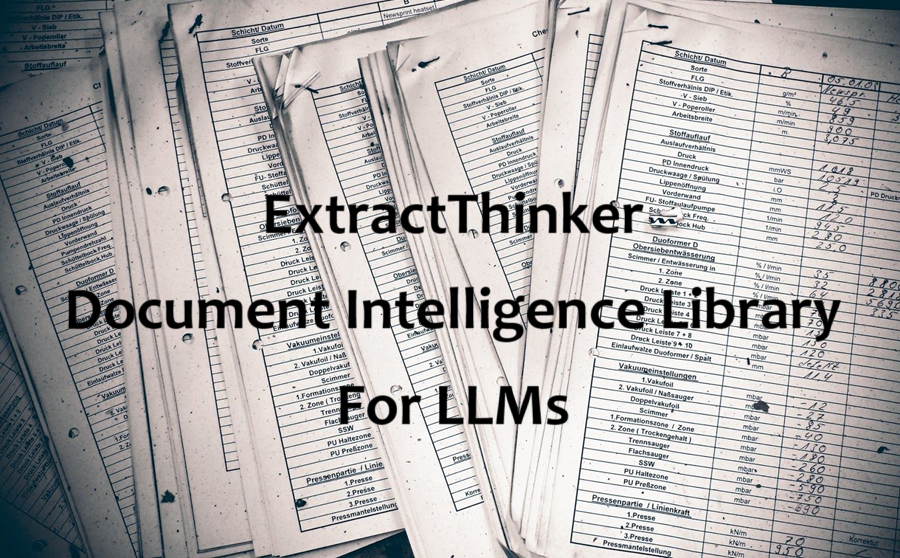ExtractThinker 文档智能处理库
ExtractThinker是一个灵活的文档智能库,可帮助你从各种文档中提取和分类结构化数据,就像文档处理工作流的 ORM 一样。

在本文中,我们将探索如何使用 ExtractThinker 高效地大规模处理文档。我们将讨论何时使用不同的模型(如 O1、GPT4o 及其迷你版本)、如何处理 OCR、提取图表以及使用异步批处理管理重负载。
1、ExtractThinker 简介
ExtractThinker是一个灵活的文档智能库,可帮助你从各种文档中提取和分类结构化数据,就像文档处理工作流的 ORM 一样。你说的一个短语是“LLM 的文档智能”或“智能文档处理的 LangChain”。其动机是创建文档处理所需的利基功能,例如拆分大型文档和高级分类。
下图映射了将要讨论的所有内容:

DocumentLoader
DocumentLoader 是文档和 LLM 之间的连接,通常在 SOTA OCR 上完成。支持多种文档加载器,包括 Tesseract OCR、Azure Form Recognizer、AWS Textract、Google Document AI 等。
LLM
它是模型的装饰器。它建立在 LiteLLM 和 Instructor 等工具之上,以方便不可知论者使用。是围绕文档智能的需求而设计的。
Contract
也是一个装饰器,但是是 Pydantic 的。目标是包括自定义功能,例如验证器和提示工程,以便自动注入和处理。
Extractor
协调文档加载器和 LLM 之间的交互以提取结构化数据。
Process
表示跨文件的流程。建立在上述组件之上。你可以为某些用例选择 DocumentLoaders以及 Extractors。
还有其他较小的组件,例如 Splitters 和 Classifications,但我们将结合适当的示例来查看它们。
2、选择正确的模型
选择合适的模型对于平衡性能、准确性和成本至关重要。首先让我们来看看成本:

GPT-4o mini
用例:基本文本提取任务,类似于 OCR。
非常适合从文档中提取文本,你必须将图像或 PDF 转换为机器可读的文本。经济高效且快速,适合大批量处理。
GPT-4o
用例:分类和拆分。
GPT-4o 模型让你对文档的内容和结构有了更多的了解。非常适合对文档进行分类、将组合文档拆分为单独的部分以及执行复杂的分类任务。
何时使用:
- 将文档分类为发票、合同或收据等类型。
- 根据内容将多页文档拆分为单独的部分。
- 高级分类,其中了解上下文和细微差别很重要。
o1 和 o1-mini 模型
用于:需要推理和从数据中得出结论的高级提取任务。
o1 和 o1-mini 模型专为复杂的提取场景而设计,其中模型需要执行更深入的分析和推理。例如,从图表中提取数据、解释值以及根据提取的坐标计算人均 GDP 等聚合指标。
何时使用:
- 根据提取的数据执行计算或生成见解。
上面的详细描述可以打包在下图中:

3、使用 DocumentLoader
在 ExtractThinker 中, DocumentLoader 是连接文档和 LLM 的关键组件。它使用 SOTA OCR 技术或直接文本提取工具从各种文档格式中提取文本和布局信息。
OCR vs. Pure Vision
仅使用 LLM 就可以完美地提取数据,但问题有两个方面:幻觉和精度。如果数据不够清晰或不够可见,就会出现幻觉。OCR 会为你提供所需的数据,而 LLM 会为你提供结构。例如,在某些带有签名的文档中,精度会成为问题,而 OCR 可以很好地处理这种情况。
因此,在生产案例中,请尝试使用启用 Vision 的 OCR。这会将 OCR 文本 + 图像添加到 LLM 请求中。

可用的 DocumentLoaders
ExtractThinker 提供多种 DocumentLoaders,包括:
DocumentLoaderTesseract:使用 Tesseract OCR 从图像或扫描的 PDF 中提取文本。DocumentLoaderPyPdf:使用 PyPDF 直接从 PDF 中提取文本,适用于数字生成的 PDF。DocumentLoaderAWSTextract:与 AWS Textract 集成以实现高级 OCR 功能。DocumentLoaderAzureForm:利用 Azure 表单识别器提取结构化数据。DocumentLoaderGoogleDocumentAI:连接到 Google Document AI 进行 OCR 和数据提取。
它包含两个主要方法,在 extract() 上调用的 load 和在 split() 中调用的 load_content_list。
从 DocumentLoader 获取内容:
import os
from extract_thinker.document_loader import DocumentLoaderTesseract
# Set the path to your Tesseract executable
tesseract_path = os.getenv('TESSERACT_PATH')
if not tesseract_path:
raise ValueError('TESSERACT_PATH environment variable is not set')
# Gets the content in JSON or just in text
content = loader.load(test_file_path)
# Gets a JSON with the content and images, per page
content = loader.load_content_list(test_file_path)4、Extractor:提取结构化数据和图表
Extractor 是 ExtractThinker 中的核心组件,可协调 DocumentLoader 和 LLM 之间的交互,以从文档中提取结构化数据。它利用 LLM 的功能根据预定义的数据结构(称为合约:Contract)解释和组织提取的文本。
合约是 Pydantic 模型,用于定义你要从文档中提取的数据的结构。它们的作用类似于 Extractor 和 LLM 用来解析和组织提取的信息的模式。
4.1 从发票中提取数据
首先定义发票合约:
from extract_thinker import Contract
from pydantic import Field
from typing import List
class InvoiceLineItem(Contract):
description: str = Field(description="Description of the item")
quantity: int = Field(description="Quantity of the item")
unit_price: float = Field(description="Unit price of the item")
amount: float = Field(description="Total amount for the item")
class InvoiceContract(Contract):
invoice_number: str = Field(description="Invoice number")
invoice_date: str = Field(description="Date of the invoice")
total_amount: float = Field(description="Total amount of the invoice")
line_items: List[InvoiceLineItem] = Field(description="List of line items in the invoice")此合约指定我们要提取发票编号、日期、总金额和行项目,每个项目都包含其详细信息。
从发票中提取数据:
import os
from extract_thinker import Extractor
from extract_thinker.document_loader import DocumentLoaderPyPdf # Or any other suitable DocumentLoader
# Initialize the Extractor
extractor = Extractor()
# Load the DocumentLoader
extractor.load_document_loader(DocumentLoaderPyPdf())
# Load the LLM
extractor.load_llm('gpt-4o-mini') # Use the appropriate model for your use case
# Define the path to your document
test_file_path = 'path/to/your/invoice.pdf'
# Perform the extraction
result = extractor.extract(test_file_path, InvoiceContract)
# Access the extracted data
print("Invoice Number:", result.invoice_number)
print("Invoice Date:", result.invoice_date)
print("Total Amount:", result.total_amount)
for item in result.line_items:
print(f"Item: {item.description}, Quantity: {item.quantity}, Unit Price: {item.unit_price}, Amount: {item.amount}")4.2 从图表中提取数据
从图表中提取数据需要更高级的合约,它可以处理图表的结构,包括其类型、描述和数据点。
定义图表合约:
from extract_thinker import Contract
from pydantic import Field
from typing import List, Literal
class XYCoordinate(Contract):
x: float = Field(description='Value on the x-axis')
y: float = Field(description='Value on the y-axis')
class Chart(Contract):
classification: Literal['line', 'bar', 'pie'] = Field(description='Type of the chart')
description: str = Field(description='Description of the chart')
coordinates: List[XYCoordinate] = Field(description='Data points in the chart')
gdp_variation: str = Field(description='Description of the GDP variation')
class ChartWithContent(Contract):
content: str = Field(description='Content of the page without the chart')
chart: Chart = Field(description='Extracted chart data')这个合约允许我们不仅提取文本内容,还可以提取图表的详细信息,包括其数据点。
提取图表数据:
import os
from extract_thinker import Extractor
from extract_thinker.document_loader import DocumentLoaderTesseract # If working with images
# Initialize the Extractor
extractor = Extractor()
# Load the DocumentLoader
tesseract_path = os.getenv('TESSERACT_PATH')
if not tesseract_path:
raise ValueError('TESSERACT_PATH environment variable is not set')
extractor.load_document_loader(DocumentLoaderTesseract(tesseract_path))
# Load the LLM (use O1 or GPT-4o for complex tasks)
extractor.load_llm("o1-preview") # Use 'o1' for advanced reasoning
# Define the path to your document
test_file_path = 'path/to/your/document_with_chart.png'
# Perform the extraction
result = extractor.extract(test_file_path, ChartWithContent, vision=True)
# Access the extracted data
print("Content without Chart:", result.content)
print("Chart Type:", result.chart.classification)
print("Chart Description:", result.chart.description)
print("GDP Variation:", result.chart.gdp_variation)
print("Data Points:")
for coord in result.chart.coordinates:
print(f"X: {coord.x}, Y: {coord.y}")注意:选择模型时,请记住经验法则。如果结论需要根据数据进行计算,在本例中,计算 GDP,必须使用 o1 模型。
5、流程:拆分和分类
在 ExtractThinker 中, Process 组件表示一个工作流,它协调从文档中加载、拆分、分类和提取数据。这种模块化方法允许你高效地处理复杂的文档处理任务。

流程简单介绍:
- 目的:管理文档的一系列操作,包括加载、拆分、分类和提取。
- 组件:结合文档加载器、拆分器、分类和提取器以创建灵活的处理管道。
- 灵活性:通过混合和匹配不同的组件,根据您的特定需求定制工作流。
5.1 拆分文档
处理多页或组合文档时,将它们拆分成单独的部分或页面对于准确处理至关重要。 ExtractThinker 提供拆分策略来有效地处理此问题。
- 急切拆分:此策略一次处理整个文档,预先识别所有拆分点。它最适合适合模型上下文窗口的小型到中型文档,为较小的输入提供更简单的实现和更快的处理速度。
- 延迟拆分:这种方法以增量方式处理文档,评估较小的块以确定拆分位置。它非常适合超出模型上下文窗口的大型文档,使其成为处理大量数据的可扩展且高效的选项。
5.2 使用拆分器
ExtractThinker 提供不同的拆分器(例如 ImageSplitter 和 TextSplitter)来处理拆分逻辑。
设置拆分器:
from extract_thinker import Process, SplittingStrategy
from extract_thinker.splitter import ImageSplitter
from extract_thinker.document_loader import DocumentLoaderTesseract
# Initialize the Process
process = Process()
# Load the DocumentLoader
tesseract_path = os.getenv('TESSERACT_PATH')
process.load_document_loader(DocumentLoaderTesseract(tesseract_path))
# Load the Splitter with the desired model and strategy
process.load_splitter(
ImageSplitter('gpt-4o', strategy=SplittingStrategy.EAGER)
)5.3 分类
分类是关于识别你正在处理的文档或部分的类型,例如发票、合同或驾驶执照。当不同类型的文档需要不同的提取逻辑时,这一点至关重要。
分类使用分类类定义,指定名称、描述和相关合同以及要使用的提取器。
使用具有多个提取器的分类:
from extract_thinker import Classification
from extract_thinker import Extractor
# Define your Contracts (as previously defined)
class InvoiceContract(Contract):
invoice_number: str
total_amount: float
# ... other fields
class DriverLicenseContract(Contract):
name: str
license_number: str
# ... other fields
# Initialize Extractors for each classification if needed
invoice_extractor = Extractor()
invoice_extractor.load_document_loader(DocumentLoaderPyPdf())
invoice_extractor.load_llm('gpt-4o-mini')
license_extractor = Extractor()
license_extractor.load_document_loader(DocumentLoaderTesseract(tesseract_path))
license_extractor.load_llm('gpt-4o-mini')
# Define Classifications
classifications = [
Classification(
name="Invoice",
description="This is an invoice document",
contract=InvoiceContract,
extractor=invoice_extractor
),
Classification(
name="Driver License",
description="This is a driver's license document",
contract=DriverLicenseContract,
extractor=license_extractor
)
]
result = process.classify(
test_file_path,
classifications,
)5.4 高级分类策略
ExtractThinker 支持高级分类策略以提高准确性和可靠性。
分类策略:
- 共识:结合多个分类器的结果以达成共识决策。
- 高阶:使用高阶推理进行更准确的分类。
- 阈值:应用置信度阈值来确定分类确定性。
高级分类:
from extract_thinker import ClassificationStrategy
# Initialize multiple Extractors for classification
extractor1 = Extractor()
extractor1.load_document_loader(DocumentLoaderTesseract(tesseract_path))
extractor1.load_llm('gpt-4o')
extractor2 = Extractor()
extractor2.load_document_loader(DocumentLoaderPyPdf())
extractor2.load_llm('gpt-4o-mini')
# Add classifiers to the process
process.add_classify_extractor([[extractor1], [extractor2]])
# Perform classification with a strategy
result = process.classify(
test_file_path,
classifications,
strategy=ClassificationStrategy.CONSENSUS,
threshold=0.8
)
print("Document classified as:", result.name)5.5 合并流程中的分裂和分类
通过结合拆分和分类,您可以高效地处理包含多种内容类型的复杂文档。
完成流程工作流:
# Initialize the Process and load components
process = Process()
process.load_document_loader(DocumentLoaderTesseract(tesseract_path))
process.load_splitter(
ImageSplitter('gpt-4o', strategy=SplittingStrategy.EAGER)
)
# Process the document
test_file_path = 'path/to/your/multi_page_document.pdf'
split_content = process.load_file(test_file_path)\
.split(classifications)\
.extract()
# Access the extracted data
for content in split_content:
if isinstance(content, InvoiceContract):
print("Extracted Invoice:")
print("Invoice Number:", content.invoice_number)
print("Total Amount:", content.total_amount)
elif isinstance(content, DriverLicenseContract):
print("Extracted Driver License:")
print("Name:", content.name)
print("License Number:", content.license_number)说明:
load_file():加载文档。split():根据分类拆分文档。extract():根据每个分类部分定义的合约提取数据。
6、异步批处理,适用于重负载
ExtractThinker 提供批处理功能,利用异步执行有效处理重负载。当响应时间不是问题时,这允许你以较低的价格处理文档。
使用批量请求:
...
# Setting the extractor as usual
path = 'path/to/your/document.pdf'
batch_job = extractor.extract_batch(
path,
InvoiceContract,
)
# can be "queued", "processing", "completed" or "failed"
status = await batch_job.get_status()
# await for the result
result = await batch_job.get_result()说明:
extract_batch:启动批量提取过程。BatchJob:表示批处理作业,允许您监视其状态并检索结果。get_status:检查批处理作业的当前状态。get_result:作业完成后检索结果。
处理批处理作业状态
批处理作业可以有几种状态:
queued:作业在队列中,即将开始处理。processing:作业当前正在处理中。completed:作业已成功完成处理。failed:作业处理失败。
批处理一次处理一个文件,因此你可以自行控制批处理数量。批处理作业管理 OpenAI API 需要创建的所有 JSONL 文件,输出也是如此。完成后,无论成功与否,都会删除文件。
总而言之,如果请求时间不是制约因素,你可以使用此 ExtractThinker 功能轻松节省 50% 的成本。
7、结束语
在数据为王的世界里,ExtractThinker 使你能够充分发挥文档的潜力。通过智能地在 GPT-4o Mini(用于快速文本提取)、GPT-4o(用于高级分类)和 O1(用于深度推理任务)等模型之间进行选择,你可以定制工作流程以实现最高效率和准确性。我们探索了选择正确的模型、使用 DocumentLoaders、使用 Extractor 提取结构化数据、使用 Processes 管理复杂的工作流程以及使用异步批处理处理重负载。
这是我在获得 API 中的 O1 模型访问权限后创建的一篇文章,它解决了几个棘手的问题,例如需要在单独代理中完成的数据聚合和计算。
ExtractThinker 即将发布,这是文档内容的汇编。
原文链接:Scaling Document Extraction with o1, GPT-4o & Mini | ExtractThinker
汇智网翻译整理,转载请标明出处